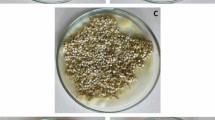Abstract
The influence of common storage condition (i.e., temperature and period) on the phytochemical contents of Korean cabbage was investigated. The total polyphenol and flavonoid contents of fresh Korean cabbage extract were 308.48 μg gallic acid equivalent/g d.w. and 5.33 μg quercetin equivalent/g d.w., respectively. Seven glucosinolate peaks were detected in Korean cabbage representing progoitrin, glucoalyssin, gluconapin, glucobrassicanapin, glucobrassicin, 4-methoxyglucobrassicin, and neoglucobrassicin based on HPLC and LC-MS analysis. The concentration of total glucosinolates in fresh Korean cabbage was 13.55 μmol/g d.w. Our results suggest that the total glucosinolate content in Korean cabbage did not much change more over 7 days of storage at 4°C but a little bit decreased in stored at ambient temperature. The extractable β-carotene, lutein as well as tocopherol contents in Korean cabbage were decreased by increasing storage period at both temperatures of 4°C and ambient temperature. Longer storage period at ambient temperature may reduce the levels of health promoting compounds. Based on our results refrigeration at 4°C can help preserve the nutritive value of Korean cabbage by maintaining high levels of glucosinolates and other bioactive compounds.
Similar content being viewed by others
References
Zhang Y, Talalay P, Cho CG, Posner GH. A major inducer of anticarcinogenic protective enzymes from broccoli: Isolation and elucidation of structure. P. Nat. Acad. Sci. USA 89: 2399–2403 (1992)
Rangkadilok N, Tomkins B, Nicolas ME, Premier RR, Bennett RN, Eagling DR, Taylor PWJ. The effect of post-harvest and packaging treatments on glucoraphanin concentration in broccoli (Brassica oleracea var. italica). J. Agr. Food Chem. 50: 7386–7391 (2002)
Farnham MW, Wilson PE, Stephenson KK, Fahey JW. Genetic and environmental effects on glucosinolate content and chemoprotective potency of broccoli. Plant Breed. 123: 60–65 (2004)
Rabot S, Nugon-Baudon L, Szylit O. Alterations of the hepatic xenobiotic-metabolizing enzymes by a glucosinolate-rich diet in germ-free rats: Influence of a pre-induction with phenobarbital. Brit. J. Nutr. 70: 347–354 (1993)
Bones AM, Rossiter JT. The myrosinase-glucosinolate system, its organization and biochemistry. Physiol. Plant. 97: 194–208 (1996)
Jia CG, Xu CJ, Wei J, Yuan J, Yuan GF, Wang BL, Wang QM. Effect of modified atmosphere packaging on visual quality and glucosinolates of broccoli florets. Food Chem. 114: 28–37 (2009)
Shapiro TA, Fahey JW, Wade KL, Stephenson KK, Talalay P. Chemopreventive glucosinolates and isothiocyanates of broccoli sprouts: Metabolism and excretion in humans. Cancer Epidem. Biomar. 10: 501–508 (2002)
Song L, Thornalley P. Effect of storage, processing, and cooking on glucosinolate content of Brassica vegetables. Food Chem. Toxicol. 45: 216–224 (2007)
Verkert R, Vandergaag MS, Dekker M, Jongen WMF. Effects of processing conditions on glucosinolates in cruciferous vegetables. Cancer Lett. 114: 193–194 (1997)
Traka M, Mithen R. Glucosinolates, isothiocyanates, and human health. Phytochem. Rev. 8: 269–282 (2009)
Hwang E-S, Jeffery EH. Evaluation of urinary N-acetyl cysteinyl allylisothiocyanate as a biomarker for intake and bioactivity of Brussels sprouts. Food Chem. Toxicol. 41: 1817–1825 (2003)
Hwang E-S, Lee HJ. Phenylethyl isothiocyanate and its Nacetylcysteine conjugate suppress the metastasis of SK-Hep1 human hepatoma cells. J. Nutr. Biochem. 17: 837–846 (2006)
Singleton VL, Lamuela-Raventos RM. Analysis of total phenols and other oxidation substrates and antioxidants by means of Folin-Ciocalteu reagent. Method. Enzymol. 299: 152–178 (1999)
Woisky RG, Salatino A. Analysis of propolis: Some parameters and procedures for chemical quality control. J. Agric. Res. 37: 99–105 (1998)
ISO. Rapeseed: Determination of glucosinolates content — Part 1: Method using high performance liquid chromatography. 9167-1: 1992(E). International Standard Organization, Geneva, Switzerland, pp. 1–9 (1992)
Stacewicz-Sapuntzakis M, Bowen PE, Kikendall JW, Burgess M. Simultaneous determination of serum retinol and various carotenoids: Their distribution in middle aged men and women. J. Micronutr. Anal. 3: 27–45 (1987)
Fenwick GR, Heany RK, Mullin WJ. Glucosinolates and their breakdown products in food and food plants. CRC Cr. Rev. Food Sci. 18: 123–201 (1983)
Hansen M, Moller P, Sorensen H, Detrejo MC. Glucosinolates in broccoli stored under controlled atmosphere. J. Am. Soc. Hortic. Sci. 120: 1069–1074 (1995)
Vallejo F, Tomás-Barberán F, Garcia-Viguera C. Health-promoting compounds in broccoli as influenced by refrigerated transport and retail sale period. J. Agr. Food Chem. 51: 3029–3034 (2003)
Davey MW, van Montagu M, Inze D, Sanmartin M, Kanellis A, Smirnoff N, Benzie IJJ, Strain JJ, Favell D, Fletcher J. Plant Lascorbic acid: Chemistry, function, metabolism, bioavailability, and effects of processing. J. Sci. Food Agr. 80: 825–860 (2000)
Author information
Authors and Affiliations
Corresponding author
Rights and permissions
About this article
Cite this article
Hwang, ES., Jang, MR. & Kim, GH. Effects of storage condition on the bioactive compound contents of Korean cabbage. Food Sci Biotechnol 21, 1655–1661 (2012). https://doi.org/10.1007/s10068-012-0220-0
Received:
Revised:
Accepted:
Published:
Issue Date:
DOI: https://doi.org/10.1007/s10068-012-0220-0




